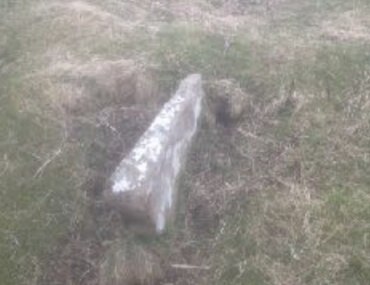Harraymen’s Graves
Published on Saturday, 14 April 2018 by David Drever

When we were on our last birdwatching walk with our friend Tim Dean we stopped for lunch at the Harramen’s graves. It was a beautiful spot with a bleak story that brings home the past harshness of Orkney life and the marginal existence of the common people.
Above the parish of Rendall and on the upper slopes of the hillside are a group of roughly cut stones, sunk into the heathery soil. They lie in a line roughly SE to NW and vary in height from a few inches above the moss to 12 inches or so, and there are seven of them visible. In the very recent past they have been marked out by temporary metal poles pushed into the soil. These stones mark the graves of a group of men from the parish of Harray, which lies on the other side of the hill from the sea-facing Rendall.
The traditionary tale from before written records, tells of a time of famine and the journey of men from Orkney’s only inland parish, Harray, to collect shellfish from the Rendall shore – ebb maet as it is called in Orkney. The men would have made their way over the hill from the toonships of Harray, probably those closest to the hill: Knarston, Mirbister, Corston or Corrigall following the well used peat roads – just rough tracks – and then down onto the Rendall shore. But on their return, probably laden with food, they were caught in a snowstorm and perished on the hillside. Perhaps the bodies lay for weeks in the snow, possibly when they were found their families were too weak to carry them back to their Harray townships. Whatever the reason they were buried where they fell on the hillside and their graves were marked by rough stones set into the moss. There is no record of the fate of these mens’ families whose famine would be worsened hugely by the loss of their menfolk.
Famine was not uncommon in an Orkney that was at the mercy of unimproved land, greedy lairds and poor weather – the Little Ice Age that afflicted most of Britain and northern Europe was at its coldest between 1600 and 1700. A combination of these factors would be disastrous for a rural population whose existence was always precarious. Written records for Harray begin in 1784 and they contain no records of this event which almost certainly happened prior to this date. George Low, minister of the joint parishes of Birsay and Harray, wrote in the Statistical Account of Orkney (1795-8) that there had been famines in 1685; 1739, 40 and 41, so it is possible the tragedy happened at one of these times. Any source of food would have been welcome and ebb maet was an important addition to poor folks’ diet. As an inland parish Harray lacked seashore, but made use of the Sandwick shore at Yesnaby where a tidal stretch still bears the name the Harra Ebb. There are no records of a similar agreement with Rendall parish, but desperation may well have driven starving men to take the shorter, but more dangerous trip in winter, over the hills for food.
On a sunlit Spring afternoon the hills were serene and the view over Rendall and the Bay of Firth was magnificent. And yet at our feet were the rude stones memorialising a more brutal time in Orkney’s past when landscape and weather were mortally unforgiving.